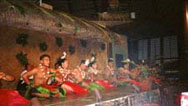Hoe Ana Te Vaka Hoe Ana Te Vaka |
 |
|---|---|
by Tahitian Folklore Group Fetia - Ra`a Tira (Recorded Circa 1980 - Tahitian
Lyrics) The dance
notes updated/corrected and translation provided by Paul Tavai Hoe Ana originates from the islands of Rarotonga (also known as Avaiki or the Cook Islands), just to the west of Tahiti. The Tahitians being more enterprising, more well known, more widely heard, recording more songs, have laid claim to many songs that are not Tahitian. Tahitian music does have a faster, more infectious beet & style for the foreign listener. The dance is of a style known in the Cook Islands as Kaparima or Ura, or commonly referred to as "Action Dances", in other words, a dance accompanied by hand gestures that are descriptive of the text. These types of dances are most commonly known to Cook Islanders by the English title of "Hand Action Songs", coincidentally a term also used by the Maori people of New Zealand. Kaparima should not be confused with the Kapa `Aparima of Tahiti - which is a very fast paced monotone rhythmical chant . All Cook Island Dance is referred to as "URA". The movements of Kaparima or URA can be either easily understandable or can be very abstract. There are some similarities to Hawaiian dance forms with which most people are familiar and sometimes these dances are referred to (mistakenly) as the Tahitian Hula, In the Cook Islands, the traditional costume for both boys and girls is what appears to be a grass skirt, but it is really a skirt made from the stripped outer bark of the Hau or wild hibiscus tree. When modern groups perform Cook Island dances there may be limited opportunities to change costumes, so they will do a Drum Dance then a Hand Action dance and go back & forth so it 'appears' that the boys wear shorter skirts. However, for Hand Action Dances in years gone by, the men used to wear longer skirts or a colorful piece of fabric tied around the hip, called a pareu (Note: Tahitian spelling: Pareo) The
song Hoe Ana recounts the days of old when the Polynesian people were
migrating from one island to another. These travelers paddled continuously
to reach land, the destination which, according to legends, lay just over
the horizon. There is tedium in the feel of the song's rhythm, which relates
to the seemingly endless paddling of these settlers, with no end in sight. Hoe Ana is a 3/4 time "waltz" with a 4/4 time faster end, simulating "Arriving to the land!" The song actually originates from Aitutaki and is about the Canoe (or Vaka ) of "RU" (in Hawaiian mythology the God - ''KU". |
|